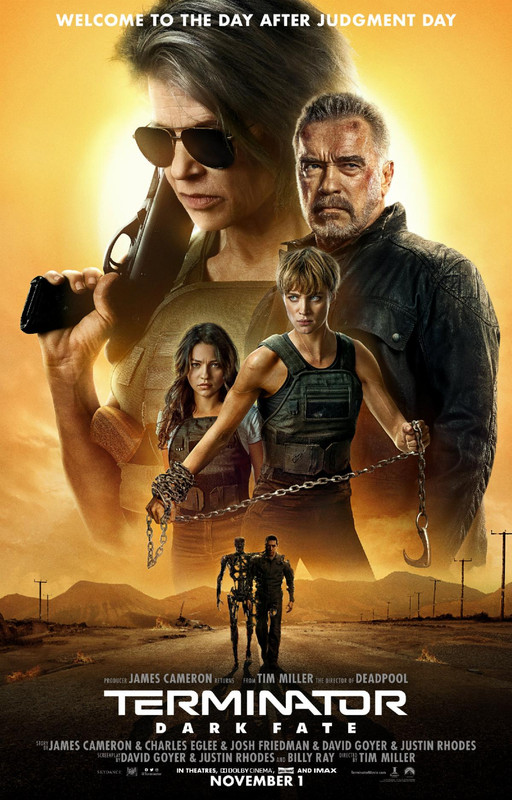Dir: Tim Miller
“There is no fate but what we make for ourselves”. For some years now, following the poorly regarded Terminator 3: Rise of the Machines, the Terminator franchise has been trying to re-make its own fate. The first attempt, Terminator Salvation, was an Arnieless excursion into the future war that had been glimpsed in every previous film. The next try, Terminator Genisys, was a full on attempt at a reboot, an abysmally terrible film that felt like the result of meeting asking how to actively take every good idea in the history of the franchise and make it shitty. Terminator: Dark Fate, arriving for the series’ 35th anniversary, feels like a last roll of the dice, and it’s trying as hard as it can to make sure those dice are loaded. Like the recent reboot of the Halloween franchise, this comes with the blessing of the original’s creator (James Cameron is credited as one of many story writers and as a producer) and turns back the clock to disregard every sequel since he was involved.
Positioned as a direct sequel to Terminator 2, the plot finds auto worker Dani Ramos (Natalia Reyes) pursued by a new kind of Terminator, the Rev-9 (Gabriel Luna), as ever, the resistance has managed to send her a protector, this time in the form of Grace (Mackenzie Davis); a human, but one with enhanced abilities. On the run, they join forces with Sarah Connor (Linda Hamilton) and later with a T-800 (Arnold Schwarzenegger) to attempt to destroy the Rev-9, to save Dani and with her the future.
There is a certain purity to the first three Terminator films. For all their plot contortions—time travel, alternate futures, continuity destroying paradoxes—they are all basically one long chase sequence. The relentlessness of them is remarkable, and drives each of them forward with a propulsive sense of purpose. This is clearly what Tim Miller and his team are trying to find with this soft reboot. They want to recapture that thrill ride feeling, but also to bring the series up to date and use it to engage with some ideas with contemporary relevance. The result is, at best, a very mixed bag.
Things largely start well. Basing the first act in Mexico, with much of the dialogue in subtitled Spanish for the opening minutes gives this film a different flavour to its predecessors and Miller wastes little time in getting to the first action scenes. Mackenzie Davis and Gabriel Luna’s first fight is solid; a brutal encounter in a car factory, it shows off some solid choreography and establishes that both Davis and Luna are adept at doing their action beats. This then leads into a truly spectacular car chase—the franchise’s best action sequence since Rise of the Machines’ crane chase—which demonstrates the abilities of the Rev-9, including the very cool aspect of splitting itself into two entities: the endoskeleton and its liquid metal covering and shows off some of the film’s best CGI. Not pausing for breath, Miller then gives Sarah Connor an entrance that befits her iconic status, Linda Hamilton instantly nails the hard-bitten attitude, creating a continuity with the first two films that, at least in the moment, is powerful and thrilling. These ten or twelve minutes of screen time are stunning; vintage Terminator fare that can stand alongside any of the highlights of the franchise. They also set a standard the film never comes close to meeting again.
Some issues are apparent even in this first part of the film. The screenplay brushes up against a few ideas: exploitation of workers and their replacement via automation, but it doesn’t do much with them. This is a pattern we’ll see repeated in how the film later avoids engaging with immigration issues, despite an action scene set in a detention centre. Happily, this isn’t the Trumpian fantasy of the recent Rambo: Last Blood , but the issues barely qualify as window dressing.
The bigger problems begin to bite after Sarah Connor’s entrance into the film. Logic has never been the strong suit of the Terminator franchise, but I found myself wondering, once a key piece of information was revealed, why Grace should be the protector sent back through the future. She possesses some of the strengths of a Terminator, but one key weakness that is more acute than those of a human, making her arguably the worst choice of the three. Her weakness serves merely as a plot device, and doesn’t add anything appreciable to her character. Nevertheless, Mackenzie Davis is very good in the part, giving it an emotional dimension reminiscent of the original’s Kyle Reese with some of the strength of Arnie’s good Terminator from the first sequel.
The writing is the problem all the way through, with the performances often seeming to work in spite rather than because of it. Natalia Reyes has much the same arc as Hamilton’s Sarah Connor did in the first film, and she plays the role well as Dani evolves from a disbelieving pawn and grows into steely resolve, but the familiarity of the arc means that she’s not terribly interesting as a character and the one minor twist on it is both screamingly obvious and something T2 did before and better, with two characters. Gabriel Luna has an intimidating blankness, but again it feels like he’s chasing another actor’s work, in this case Robert Patrick. The new abilities of the Rev-9 are fun for a while, but again could be more inventively utilised. The first act suggests that Dark Fate will have the same relentless drive as the first three films, but somehow this too goes missing. The middle hour flags quite substantially, as we have to team Sarah up with Grace and Dani and have them find Arnie’s T-800. During this section, Luna is mostly off screen, and the ever present sense of threat from the T-800 in the first film and the T-1000 in the second just doesn’t translate here.
Though he is of course top billed, this is probably Arnold Schwarzengger’s most limited screen time in the franchise, leaving aside his digital cameo in Salvation. One thing that often goes under acknowledged is that each time Schwarzenegger plays the Terminator, he is reinventing the character; the face may be the same, but he’s a different Terminator each time. In this respect, as little sense as his very existence makes in this timeline, there are some nice ideas here. ‘Carl’, as this T-800 is known, has built a life over the past 20 years. It would have been interesting to see this be more than window dressing and the source for a couple of jokes, but Arnie plays both the humour and the Terminator’s slightly evolved understanding of emotion effectively for the little screen time he’s allowed to work with it. It’s a good performance which is somewhat derailed by the fact the film seems shackled to striking as close to the shape of its best-loved predecessors as possible, meaning that come the third act Arnie is just a Terminator again, any evolution he’s done largely a moot point.
Having been away from the franchise for 28 years, Linda Hamilton must have seen something worth getting involved in here. It’s true that Sarah Connor is probably the character best served by the screenplay, and Hamilton falls back into the role perfectly. The years visible in Sarah’s face attest to the tragic backstory, and Hamilton communicates both this and her distrust of the T-800 effectively. Again, even in the baggy middle hour, it’s not all that deep, but Hamilton hits all the emotional beats well enough to get maximum effectiveness from minimal development. Sarah’s presence is pure fanservice, but it’s well-executed fanservice in the middle of a film that otherwise often fails on that level.
Tim Miller, fortunately, doesn’t try to translate the tone of Deadpool to this film, the moments of humour are few, mostly solidly executed and, in fairness, less obtrusive than in Rise of the Machines. Miller does marshal some decent action sequences, though they are customarily over-reliant on CG and the rhythm of them feels off, with the unquestionable highlight coming with the first of the setpieces and the film feeling like it’s chasing that same high throughout, without hitting it. The CG is also problematic at times, with the first sequence in which it’s used looking shockingly shonky in one hugely important aspect (I won’t spoil it, because it has been well protected by the trailers). Outside the action, the screenplay again lets the side down, as it looks for an ending with the same kind of pathos as T2, and comes up empty.
Terminator: Dark Fate is a major step up from Salvation and Genisys, but that is much more an indictment of those films than an endorsement of this one. Every one of its successes is partial or compromised. The first twenty minutes are thrilling, but thereafter the film flags badly, throws out a lot of ideas it never quite utilises effectively and when it stutters to life it recalls the earlier, better, films so much—without hitting the same level of quality—that it only serves to make you wish you were just watching those again. For all its flaws, Rise of the Machines remains underrated and its dystopian ending maybe the franchise’s boldest choice. Dark Fate does nothing so interesting. It has some virtues, but its legacy will likely be as the second-best Terminator 3.
★★½




No comments:
Post a Comment